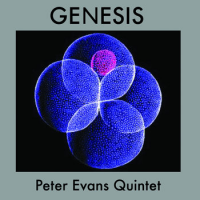Home » Jazz Articles » Album Review » Peter Evans Quintet: Genesis
Peter Evans Quintet: Genesis
Genesis is the most ambitious quintet project launched by the avant-garde trumpeter/composer, especially in terms of the exceedingly collaborative group model. Recorded live during a 2015 European tour, the album features almost one-hundred minutes of music; the quintet—not surprisingly—pushing boundaries even while producing their most accessible recording to date.
The bulk of the collection goes to two multi-part suites. "Genesis / Schismogenesis" consists of four sections (labeled as 'stages') and another five-part suite interestingly named "3 for Alice (Coltrane)." Evans' solo opening on "Fanfares Introduction" is closer to his abstract work on his very recent solo trumpet album Lifeblood (More is More, 2016). The main piece—"Fanfare"—finds a melodic center if not necessarily a setting down point. Each section of "Genesis / Schismogenesis (Stage 1-Stage 4)" vacillates between serenity and visceral attacks.
The fifteen-plus minute "Patient Zero (15 scenes)" is the most abstract of the pieces on Genesis. Stabinsky occasionally dropping in phrases that sound a bit like the theme from The Twilight Zone, while Evans splutters and growls in an agitated manner. As the tension builds to a crescendo, the piece quiets down to a reverential state and then explodes again. To say that "3 for Alice (Coltrane):Elementary" swings, is misleading. The sheer force of Evans' power and Stabinsky's torrent of notes, at breakneck speed, would knock traditionalists off their feet.
Genesis is more a group effort than a showcase for solos, though there are some fine ones, especially from Evans and Stabinsky. The quintet often sounds like a larger ensemble likely due to the live electronic enhancements of Black and Pluta. In most cases, however, Evans takes care to nuance the use of programmed elements and blends them with the acoustics in an organic manner. It's Evans' nature to occasionally allow the group to happily head into the weeds, but they claw their way back and forth from center, ready to get muddy again. In an increasingly formulaic music world, Evans remains true to his experimental approach; he is not making music burdened by the goal of mass appeal but guided by a unique creative compass.
Track Listing
Fanfares Introduction; Fanfares; Genesis / Schismogenesis Stage 1; Genesis / Schismogenesis Stage 2; Genesis / Schismogenesis Stage 3; Genesis / Schismogenesis Stage 4; Patient Zero (15 scenes); 3 for Alice (Coltrane): Intergalactic; 3 for Alice (Coltrane):Interlude 1; 3 for Alice (Coltrane):Elementary; 3 for Alice (Coltrane): Interlude 2; 3 for Alice (Coltrane): 12 Earthly Branches.
Personnel
Peter Evans
trumpetPeter Evans: trumpet; Ron Stabinsky: piano; Tom Blancarte: double bass; Jim Black: drums and live processing; Sam Pluta: live processing.
Album information
Title: Genesis | Year Released: 2016 | Record Label: More Is More Records
< Previous
Sedimental You
Next >
Out Of The Blue
Comments
Tags
For the Love of Jazz
 All About Jazz has been a pillar of jazz since 1995, championing it as an art form and, more importantly, supporting the musicians who create it. Our enduring commitment has made "AAJ" one of the most culturally important websites of its kind, read by hundreds of thousands of fans, musicians and industry figures every month.
All About Jazz has been a pillar of jazz since 1995, championing it as an art form and, more importantly, supporting the musicians who create it. Our enduring commitment has made "AAJ" one of the most culturally important websites of its kind, read by hundreds of thousands of fans, musicians and industry figures every month.




















